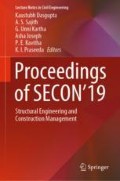Abstract
One of the main causes of reinforced concrete degradation is chloride-induced corrosion. Chloride-induced corrosion depends on many factors like properties of the material, loading on the structure and environmental condition. There is much research on the deterioration of concrete structures over the years; but there is relatively little research on changing climate affecting the deterioration, which is the topic of this paper. The present study is purely analytical wherein conceptual T-Beam bridge girder has been taken for the prediction of time to corrosion initiation and corrosion propagation, incorporating effect of climatic condition. For comparison, eight study locations are selected. Corrosion initiation time is predicted for each location considering the climatic data of the corresponding location. With the variation in the temperature and relative humidity data at different study location, large variation in corrosion initiation time is found.
Access this chapter
Tax calculation will be finalised at checkout
Purchases are for personal use only
References
Tuutti K (1982) Corrosion of reinforcement in concrete. CBI report, Swedish Cement and Concrete Research Institute, Stockholm, vol 4, p 82
Stewart MG, Rosowsky DV (1998) Structural safety and serviceability of concrete bridges subject to corrosion. J Infrastruct Syst 4(4):146–155
Parrott LJ (1991) Factors influencing relative humidity in concrete. Mag Concr Res 43(154):45–52
Andrade C, Castillo A (2003) Evolution of reinforcement corrosion due to climatic variations. Mater Corros 54(6):379–386
Allampllewar SB, Srivdya A (2008) Corrosion initiation time for reinforced concrete members along Indian coast: effects of temperature and relative humidity—A probabilistic approach. Constr Build Mater 15:539–553
El Hassan J, Bressolette P, Chateauneuf A, EL Tawil K (2010) Reliability-based assessment of the effect of climatic conditions on the corrosion of RC structures subjected to chloride ingress. Eng Struct 32:3279–3287
Alhozaimy A, Hussain RR, Al-Zaid R, Al-Negheimish A (2012) Coupled effect of ambient high relative humidity and varying temperature marine environment on corrosion of reinforced concrete. Constr Build Mater 28:670–679
Collepardi M, Marcialis A, Turriziani R (1972) Penetration of chloride ions into cement pastes and concretes. J Am Ceram Soc 55(10):534–535
Crank J (1975) Mathematics of diffusion. Oxford University Press, Oxford
Lindvall A (1999) Environmental actions and response—survey, inspection and measurement. Working Report, The European Community Brite EuRam Project BE95-1347, Task 7 report
Lindvall A (2001) Environmental actions and response: reinforced concrete structures exposed in wind and marine environments. Thesis for Degree of Licentiate of Engineering, Department of Building Materials, Chalmers University of Technology, Goteborg
Fib (2006) Model code for service life design. fib Bulletin 34, International Federation for Structural Concrete, Lausanne
Bentz E, Thomas M (2000) Manual of computer program for predicting the service life and life cycle costs of reinforced concrete exposed to chlorides, pp 1–55
Samson E, Marchand J (2007) Modeling the effect of temperature on ionic transporting cementitious materials. Cement Concr Res 37(3):455–468
Saetta AV, Scotta RV, Vitaliani RV (1993) Analysis of chloride diffusion into partially saturated concrete. ACI Mater J 90(5):441–451
Breysse D, Yotte S, Salta M, Schoefs F, Ricardo J, Pereira E (2008) Uncertainties in NDT condition assessment of corroding structures in marine environment. MEDACHS08, Construction heritage in coastal and marine environments. Damage, diagnostics, maintenance and rehabilitation (Lisbon, Portugal), LNEC
Bamforth PB (1999) The derivation of input data for modeling chloride ingress from eight-year UK coastal exposure trials. Mag Concr Res 51(2):87–96
Ababneh A, Benboudjema F, Xi Y (2003) Chloride penetration in non-saturated concrete. J Mater Civ Eng
Val DV, Melchers RE (1997) Reliability of deteriorating RC slab bridges. J Struct Eng 123(12):1638–1644
Stewart MG (2009) Mechanical behaviour of pitting corrosion of flexural and shear reinforcement and its effect on structural reliability of corroding RC beams. Struct Saf 31(1):19–30
Stewart MG, Al-Harthy A (2008) Pitting corrosion and structural reliability of corroding RC structures, experimental data and probabilistic analysis. Reliab Eng Syst Saf 93(3):273–382
Darmawan MS (2010) Pitting corrosion model for reinforced concrete structures in a chloride environment. Mag Concr Res 62(2):91–101
Val DV (2007) Deterioration of strength of RC beams due to corrosion and its influence on beam reliability. J Struct Eng 133(9):1297–1306
Du YG, Clark LA, Chan AH (2005) Residual capacity of corroded reinforcing bars. Mag Concr Res 57(3):135–148
Attri SD, Tyagi A (2010) Climate profile of India. India Meteorological Department, New Delhi
Author information
Authors and Affiliations
Corresponding author
Editor information
Editors and Affiliations
Rights and permissions
Copyright information
© 2020 Springer Nature Switzerland AG
About this paper
Cite this paper
Ranjith, A., Balaji Rao, K., Thripthi, Tanvi Rai, A., Manjunath, K. (2020). Reliability Analysis of RC T-Beam Bridge Girder Subjected to Chloride-Induced Corrosion. In: Dasgupta, K., Sajith, A., Unni Kartha, G., Joseph, A., Kavitha, P., Praseeda, K. (eds) Proceedings of SECON'19. SECON 2019. Lecture Notes in Civil Engineering, vol 46. Springer, Cham. https://doi.org/10.1007/978-3-030-26365-2_37
Download citation
DOI: https://doi.org/10.1007/978-3-030-26365-2_37
Published:
Publisher Name: Springer, Cham
Print ISBN: 978-3-030-26364-5
Online ISBN: 978-3-030-26365-2
eBook Packages: EngineeringEngineering (R0)

